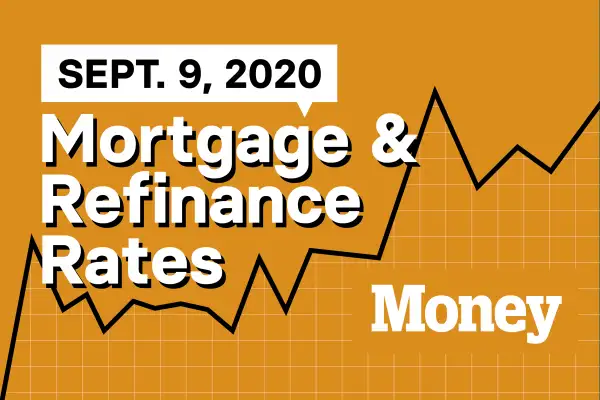Here Are Today's Best Mortgage & Refinance Rates for September 9, 2020

Borrowers with 700 credit scores were quoted an average rate of 3.431% to secure a 30-year fixed-rate purchase mortgage on Tuesday, according to Money's survey of over 8,000 lenders across the United States. At this credit score, roughly the national average, the average rate for a 30-year refinance was 4.387%. Our rates include discount points and are for borrowers putting 20% down.
| 30-year fixed-rate purchase mortgage |
| 3.431% |
| Rate of September 8, 2020 |
Borrowers in Washington, D.C. were quoted the lowest mortgage rates on Tuesday—at 3.264%. Those in Georgia saw the highest average rate at 3.659%. Nationwide, borrowers with the highest credit scores, 740 and above, were quoted rates averaging 3.085%, while those with credit of 640 or below were given rates of 4.864%—a 1.779 percentage point spread.
You may be able to negotiate a lower rate if you shop around or if you have other accounts with the lender. Currently, some banks are hiking up advertised rates to keep demand in check, so you may be offered a lower rate if you reach out directly.
Freddie Mac's widely quoted Primary Mortgage Market Survey put rates at 2.93% with 0.8 points paid for the week ending September 3. The mortgage purchaser's weekly survey reflects borrowers who put 20% down on conforming loans and have excellent credit.
Refinance rates today
Money's survey shows that the offered rate for a 30 year refinance for someone with a 740 credit score was 3.593% on Tuesday. Last September, the average mortgage rate (including fees) was 3.922%.
| 30-year fixed-rate mortgage refi |
| 3.593% |
| Rate of September 8, 2020 |
A homeowner with a $200,000 mortgage balance currently paying 3.922% on a 30-year loan could potentially cut their monthly payment from $946 to $909 by financing at today's lower rates. To determine if it's worth it to refinance your mortgage, also consider the closing fees you paid on your current mortgage, how much your new lender is charging and how long you have left on your loan term. (Our picks for the best lenders for refinancing are here).
What else is happening in the housing market right now?
The second quarter of 2020 saw the largest mortgage origination volume on record with $1.1 trillion in first lien mortgage originations, according to real estate data provider Black Knight's Mortgage Monitor Report. Refinance activity was up 60% over first quarter and doubled since the second quarter of 2019, making up almost 70% of all originations by dollar value.
As impressive as these second quarter numbers are, third quarter numbers may get even higher as the typical spring buying season was pushed back to summer by the COVID-19 pandemic. Based on rates that have already been locked in for the third quarter, Black Knight is forecasting the number of purchase loans originated between July and September could be 30% to 40% higher than in a typical year. Refinance activity is also on track to break third quarter records.
"With market conditions as they are and given the recent delay of the 50 basis points fee on GSE refinances until December, we would expect near-record low interest rates to continue to buoy the market," said Ben Graboske, president of Black Knight. "After all, there are still nearly 18 million homeowners with good credit and at least 20% equity who stand to cut at least 0.75% off their current first lien by refinancing."
In spite of the high volume of refinancing activity, loan servicers are having a hard time retaining borrowers. Just 18% of all refinancing borrowers stayed with their original loan servicer.
Meanwhile, weekly mortgage loan applications were back in positive territory as low mortgage rates lured both home buyers and owners back into the market. According to the Mortgage Bankers Association, the total volume of applications increased 2.9% on a seasonally adjusted basis from the previous week, with purchase loans increasing 3% week-over-week. Refinance loan applications were also up 3%. Year-over-year, purchase applications were up 40% and refinance loans were up 60%. This week's numbers were compared to Labor Day week in 2019.
The total number of loans in forbearance decreased to 7.16%, down 4 basis points from last week, according to the MBA. The share of Fannie Mae and Freddie Mac loans in the payment deferral program dropped 8 basis points to 4.80%, the thirteenth week of declines for the government secured loans. Meanwhile, the share of portfolio loans and private-label securities ticked down 1 basis point to 10.43%. However, Ginnie Mae loans in forbearance were up for the second straight week, increasing 4 basis points to 9.62%.
While the number of loans in forbearance has been trending downward for the most part, there is still an estimated 3.6 million homeowners taking advantage of the program. Unemployment remains a roadblock to recovery despite recent gains in the job market.
"The labor market continued to heal in August, with strong job growth and a large decline in the unemployment rate. However, the economy still faces an uphill climb and remains far away from full employment," said Mike Fratantoni, chief economist for the MBA. "High unemployment, and jobless claims consistently around 1 million a week, continue to cause financial strain for some borrowers - and especially for those who work in industries hardest hit by the pandemic."
Quote of the Week
More great housing content from Money.
I feel like I wasn't really even given the opportunity to move fast because it went so fast," said house hunter Lindsey Morris on losing out on her dream home.
From: Bidding Wars Are Back. Here's How to Win
Bottom line:
The Overlooked Reason It's So Hard to Buy a Home in 2020
When Will It Get Easier to Buy a Home? 8 Experts on the Nation's Housing Shortage

